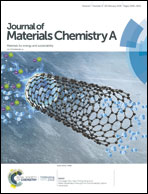Massively enhanced ionic transport in irradiated crystalline pyrochlore†
Abstract
Crystalline disorder in complex oxides can have a pronounced effect on mass transport, but the role of disorder within the complex landscape of material and microstructural defects is not uniquely understood. In this work, we use radiation damage, not to study the fundamental damage response, but rather as a tool to induce and control the extent of disorder of a single oxide composition in order to explore the relationship between intrinsic disorder and transport. Thin films of the ordered pyrochlore Gd2Ti2O7 (GTO) were irradiated with light ions and transitioned from ordered pyrochlore to disordered crystalline defect fluorite to an amorphous structure, disordering monotonically with increasing fluence, but nonhomogeneously throughout the film. Conductivity increased substantially with increasing disorder, where only slight disordering results in the majority of the change in conductivity. Additionally, while the pristine GTO films exhibited mixed ionic and p-type electronic conductivity, the total conductivity of the material that exhibited maximum disorder prior to the onset of amorphization was ionic in nature.



 Please wait while we load your content...
Please wait while we load your content...